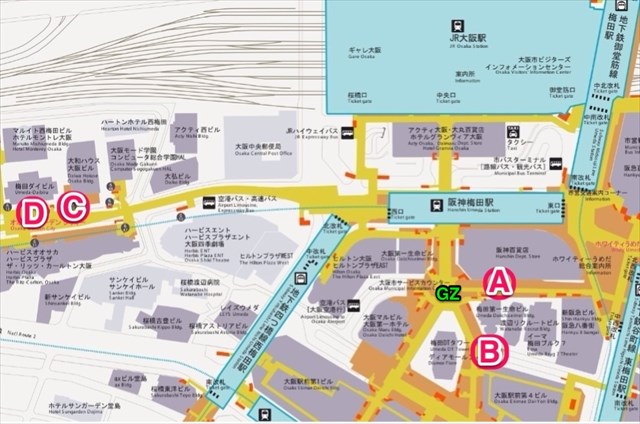When we learn about the earth, We observe riverbank of stone and the cliff of the rock, it's difficult to excavate the fossil. The place that can observe various kinds of rocks in the outdoors is limited. However, we can observe it's a great variety of rocks were limited, and there is a convenient place prepared as a specimen polished neatly, besides. It's in the basement of the city lined with buildings.
Many of the buildings in the town are no interesting in reinforced concrete. However, in the underground, We can observe different apparent things in the same rock. And we can easily distinguish because there are many characteristic rocks. Enjoy the Urban Geology by observing to examine the fossil and rock in the basement of the city.
Please enjoy the fossil search with reference to the attached MAP, because the cache area is hard to use GPS equipment in underground.
Umeda underground district is world's most complex. Observable time AM7: 00 ~ PM22: 00
◎Umeda underground map

Extended MAP(A.B)(C.D)
GZ
Observation point photo(A)(B)(C)(D)
Various rocks are used as building stones in a building of Umeda. Let's learn about the marble which fossils are seen in well here.
Marble
By the classification of the rock, marble means a metamorphic rock of the limestone. However, limestone that is not subject to metamorphism in the stone industry also means the marble. Because originally the corpses of a calcic creature inhabiting the coral reef piled up as for the limestone, it's constructed with some impurities, and, by degree of the metamorphism, the variety of the color varies. Above all, the marble right here has little metamorphism.
①.Limestone including the nummulite
It is limestone including the thin discal fossil of the rolls at 1-3cm in diameter. Nummulite is the fossil of the protozoal friend of the single cell. This is because it contains nummulite, It is the one that is made of shallow tropical sea of the Cenozoic era of the Paleogene (65 million years to 2400 million years ago).
②.Jurassic yellow
As you can see from the name, the formation of this stone was constructed in the Jurassic. This was stratum approximately 200 million years ago, and the face of the Earth was the times when a dinosaur and many creatures prospered. You will find a lot fossil of Ammonite and Beremunaito from this stratum. The Beremunaito, It is a friend of squid extinct in the late Cretaceous.
③.Slate stone limestone(Solnhofen)
The surface of the slate is rough, but the inside is very granular limestone. This Slate stone limestone is found many fossil ammonites and crinoids.
④.It consists of limestone ③ same, but Fossil of coral colony is included in this limestone.
Task
1.Point ABCD of MAP, are made of ①②③④marble. Please e-mail cache owner (moramora1) each combination and reason.
2.Please tell me the number and the kind of the fossil which you discover and observed it in this Earthcache.
Option:(If possible) Please post photo of fossil which you like most.
◎This earthcache is created by the advice of the Osaka Museum of Natural History.
-Japanese-
私たちが地球について学ぶ時、河原にころがっている石ころや崖を作っている岩石を観察したり、化石を発掘したりすることはなかなか難しいことです。野外で色々な種類の岩石を観察できる場所も限られています。ところが、多種多様な岩石を限られた範囲で観察でき、しかもきれいに磨かれた標本としてそろっている便利な場所があるのです。それはここ、ビルが立ち並ぶ都会の地下にあります。
街中のビルの多くは鉄筋コンクリート造りで味気ないものが多いですが、地下に入れば研磨されていて鉱物どうしの関係がわかるものやザラザラして自然に近い表面のものなど、同じ岩石でも違った見かけのものが観察できます。そして特徴的な岩石が多いため、簡単に見分けることもできます。都会の地下で岩石や化石を調べ観察してUrban Geologyを楽しみましょう。
キャッシュポイントは地下であり、GPS座標の測定は困難ですので、添付MAPや観察地点写真を参考にしてください。
梅田の地下街は世界一複雑とも言われています。観察可能な時間AM7: 00 ~ PM22: 00
◎梅田地下街MAP

MAP拡大図(地点A.B)(地点C.D)
GZ
観察地点写真(A.ディアモール大阪通路壁)(B.円柱)(C.大和ハウス入口前の柱)(D.ダイビル入口前の柱)
梅田のビルには様々な岩石が石材として利用されています。ここでは化石がよく見られる大理石について学びましょう。
大理石
岩石の分類では、石灰岩が変成作用を受けた変成岩を大理石といいますが、石材業界では変成作用を受けていない石灰岩も大理石とよんでいます。石灰岩はもともとサンゴ礁に生息する石灰質の生物の遺骸が積み重なったものであるため、若干の不純物と一緒にたまっており、変成作用の程度により、色のバラエティーも様々です。中でもここでよく見られるのは変成作用の少ない大理石です。
①.貨幣石を含む石灰岩
直径1〜3cmで渦巻模様の薄い円盤状の化石を含んだ石灰岩です。貨幣石とは単細胞の原生動物のなかまの化石です。貨幣石を含んでいることから、新生代古第三紀(6500万年〜2400万年前)という時代の熱帯の浅い海でたまったことがわかります。
②.ジュライエロー
名前からもわかるように、この石の地層はジュラ紀のものです。今から約2億年前の地層で、地球上は恐竜や多くの生物が繁栄していた時代でした。この地層からはアンモナイトやベレムナイトの化石がたくさん見つかります。ベレムナイトとは、白亜紀末に絶滅したイカの仲間です。
③.石板石石灰岩(ゾルンホーフェン)
石板の表面はざらざらしていますが、内部は非常にきめ細かい石灰岩です。ドイツのゾルンホーフェンの石板石石灰岩からはアンモナイトやウミユリの化石が多く見つかります。
④.③と同じ石灰岩かならなりますが、この石灰岩には群体サンゴ化石がみられます。
タスク
1.MAPの地点A.B.C.Dで石材に使われている岩石を観察してください。地点A.B.C.Dにある石材は①.②.③.④何れかの大理石で作られています。それぞれの組み合わせと、その根拠(○○の化石が含まれるからなど)をキャッシュオーナー(moramora1)にメールしてください。
2.あなたがこのEarthcacheで発見し観察した化石の個数と種類を教えてください。
(オプション)可能であるならば、あなたが最も気に入った化石の写真をログにUpしてください。
◎このEarthcacheは大阪市立自然史博物館の助けを得て作成されました。